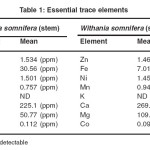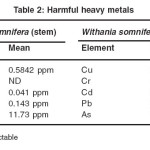Trace metal analysis in Withania somnifera
Dr. Jaya Gupta
Department of Chemistry, Agra College, Agra
DOI : http://dx.doi.org/10.13005/ojc/290334
Article Received on :
Article Accepted on :
Article Published : 28 Oct 2013
The stem and seeds of Withania somnifera were digested with HNO3 and HClO4 (4:1) and the contents of thirteen trace elements such as Zn, Fe,Ni, Mn ,K ,Ca, Mg, Co, Cr, Cu, Cd, Pb, and As from different parts were determined by atomic absorption spectroscopy. The experimental results confirmed the presence of Fe, Ca, Mg, Zn, Ni, Co and Mn which are beneficial to the human body is within the limit and K is not detected. The heavy trace element which are harmful to human body i.e., Cd, Pb, Cu within the limit but As is higher and Cr is not detected.
KEYWORDS:Atomic absorption spectroscopy;Withania somnifera;Trace elements
Download this article as:| Copy the following to cite this article: Gupta J. Trace metal analysis in Withania somnifera. Orient J Chem 2013;29(3). doi : http://dx.doi.org/10.13005/ojc/290334 |
| Copy the following to cite this URL: Gupta J. Trace metal analysis in Withania somnifera. Orient J Chem 2013;29(3). Available from: http://www.orientjchem.org/?p=327 |
INTRODUCTION
Withania somnifera belongs to family Solanaceae, also known as ashwagandha, winter cherry and Indian ginseng. It is an important herb in the ayurvedic and indigenous medicinal system of India. Therapeutic importance of the different part of this plant has a long history and mentioned in Charak Sanghita. Its height is 3-4 feet and grows into a bush. It is used as an antistressor1 and antioxidant agent 2. Withania somnifera is an ingredient in many formulations prescribed for a variety of musculoskeletal condition (e.g., rheumatism, arthritis3) and as a general tonic to increase energy, improve overall health, and prevent disease in athlete and during pregnancy4. It has anti inflammatory5, hyperthyroid activity6. In India, at present for medicinal purpose Withania somnifera is cultivated.
In recent years people pay important attention to the research of trace element distribution in medicinal plants7-8 because trace elements are the essential parts for human health and prevention of diseases. The atomic absorption spectroscopy9-10 is an important method for detection of trace elements. Some other methods are electromagnetic coupling plasmatic emitting spectrometry11-12, atomic fluorescent spectrometry13, and electromagnetic coupling plasma14.
EXPERIMENTAL
Stem and seeds of Withania somnifera is picked from Shahjahan garden, Agra. This is identified by Head of the Botany Department. For fifteen days, the samples are air dried under shade. Then powdered with the help of warning blender, 2.5gm ground dried plant samples was place in a 250 ml conical flask 2.5 ml concentrated HNO3 was added slowly with constant shaking. The mixture was heated on a hot plate until the production of brown fumes ceases. Cool the content of beaker and add 10 ml of 70% HClO4. Heated again very gently until the solution turns colorless and allow to evaporating to a small volume. Cool and add double distilled water and filter into a 100 ml flask using Whatmann filter paper and dilute volume with double distilled water. The total concentrations of Zn, Fe, Ni, Mn, K, Ca, Mg ,Co, Cr, Cu, Cd, Pb, As etc. were analyzed by atomic absorption spectroscopy (Model: Perkin Elmer A Analyst 100)
 |
(Table: 1) ESSENTIAL TRACE ELEMENTS Click here to View table |
 |
(Table: 2) HARMFUL HEAVY METALS Click here to View table |
RESULTS AND DISCUSSION
The concentration of copper in stem is 0.5842 ppm and in seed is 0.4775 ppm in edible plants permissible limit set by FAO/WHO in 1984 was 3.00 ppm. Thus in Withania somnifera copper is within limit.
The concentration of cadmium in stem is 0.041 ppm and in seed is 0.038 ppm. The permissible limit set by WHO is 0.2 to 0.81 ppm. Thus in Withania somnifera concentration of cadmium in stem and seed with in limit. Cadmium is a non essential trace element. Cadmium causes high blood pressure. Cd damages kidney and liver15.
The concentration of lead in stem is 0.143 ppm and in seed is 0.120 ppm. The permissible limit set by WHO is 0.1 to 10 ppm. Thus lead in Withania somnifera is within limit. Excess of lead checks formation of hemoglobin.
The concentration of arsenic in stem is 11.73 ppm and in seed is 11.72 ppm. In medicinal plants concentration of arsenic recommended is less than 1.0 ppm16. So it is higher in Withania somnifera. Excess of arsenic causes metabolic disorder, dermatitis, lung cancer, cardiovascular and neurological effects.
In Withania somnifera concentration of Ni in stem is 1.501 ppm and in seed is 1.453 ppm. In 1984 FAO/ WHO set permissible limit for Ni is 1.683 ppm. No limit yet been given by WHO in 2005 for Ni in medicinal plants. Ni plays an important role in the production of insulin. Lungs are adversely affected by Ni and it is identified as a suspected carcinogen. Ni in Withania somnifera is within limit.
In stem concentration of iron is 30.56 ppm and in seed Fe is 7.01 ppm. For Fe in medicinal plants limits not yet been established by WHO in 2005. For the formation of hemoglobin iron is necessary. For the transfer of oxygen and electron transfer Fe is required in human body17.
No Cr and K have been determined in stem and seed. Withania somnifera has a content of useful trace elements within limit i.e., Mg, Ca, Fe, Mn in stem and seed.
Thus on the basis of above results, it is found that Withania somnifera contain useful trace elements Fe, Mg , Ca, Mn, Ni, Zn, Co with in limit . Harmful heavy metals Cu, Cd, Pb are also with in limit but concentration of As is higher.
ACKNOWLEDGEMENT
I am very grateful to University Grants Commission, New Delhi, India for their financial assistance (Grant No.F.15-39/12 (SA-II)). I am also very thankful to Dr. A. K. Gupta , Dr.Amit Gupta and Head of the Department Dr. S.C.Goyal for their support.
REFERENCES
- Bhattacharya, A., Ghosal, S. and Bhattacharya, S.K., J. Ethnopharmacol, 74,1-6, (2001).
- Dadkar, V.N., Ranadive, N.U. and Dhar, H.L., Ind J Clin Biochem, 2,101-108, (1987).
- Sulaiman, S.A., Int. J. Mendel, 27(1-2), 13-14, (2010).
- Bone, K., Clinical applications of Ayurvedic and Chinese herbs, Monographs for the Western herbal practicioner, Aust. Phytoetherapy Press. 137-41, (1996).
- Anbalangan, K. and Sadique. J., Indian Journal of Experimental Biology, 19, 245-249, (1981).
- Panda, S. and Kar, A., J Ethnopharmacol, 67,233-239, (1999).
- Wang, Y., Wang, S.J. and Wang, L.X., China Pharmacol. J., 39, 877, (2004).
- Zhang, S.B., and Guo, Y.S., Chin.J. Health Lab. Technol., 46, 15, (2005).
- Liu,C.H., Wang, C.H., and Liu, Z.P., Spectrosc.Spect. Anal., 28, 686, (2008).
- Liang, B.A., and Zhang F.J., Spectrosc. Spect. Anal., 27, 813, (2007).
- Zhang,S.B., Zhang , X.Z. and Guo,Y.S., Spectrosc. Spect. Anal., 24,1260 (2004).
- Chen,J., Yao,C., and Ou-Yang,P.K., Spectrosc. Spect.Anal., 25, 560,(2005).
- Chen,S.Z., Spectrosc. Spect Anal., 23,993, (2003).
- Kou, X.M., Xu,M. and Gu,Y.Z., Spectrosc. Spect.Anal., 27,1197, (2007).
- Neil, P.O., Minor Element and Environmental Problems, Environmental Chemistry, 2nd Ed. 96, (1993).
- WHO, Monographs on Selected Medicinal Plants , Vol.1 World Health Organization , Geneva (1999)
- Kaya, I., and Incekara,N., J. Turkish Weed Sci., 3, 56-64, (2000).

This work is licensed under a Creative Commons Attribution 4.0 International License.









